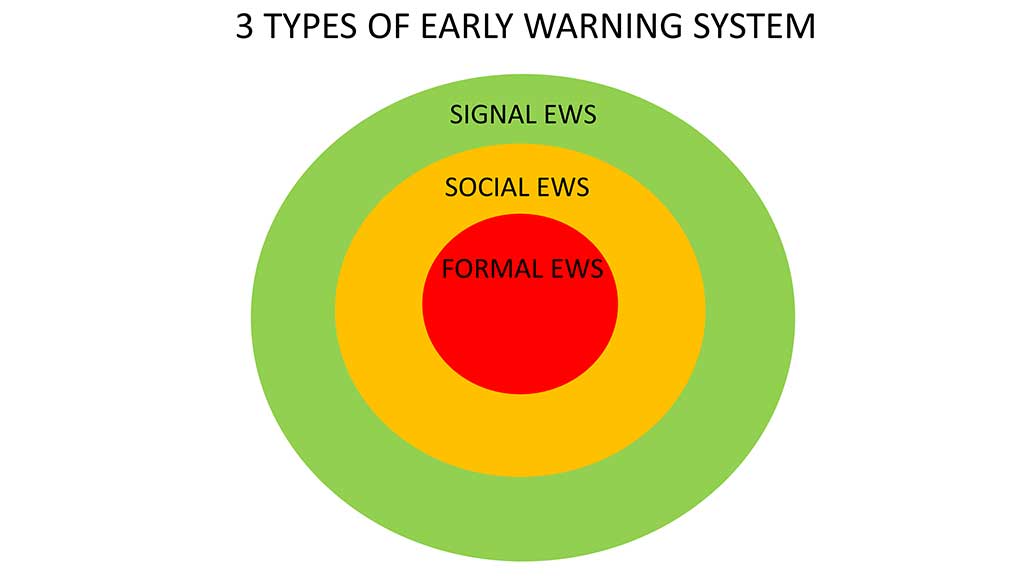There are 3 types of Early Warning Systems (EWS) - Formal, Social and Signal – think of them as 3 concentric rings with the Formal one at the centre.
You need all 3 circles to succeed in your projects and ventures – however some leaders only rely on the inner circle – the Formal EWS.

FORMAL (or SUPERVISORY) Early Warning Systems
This is the easiest form of EWS as you get most of it automatically from good disciplines around Project Planning and Project Management.
The three key characteristics of a Formal EWS are:
1. A Project Plan with Milestone Review Points & Review Mechanisms
2. Project Progress Indicators - typically resource, cost and timescales
3. Project Value Indicators tracking the value the project is creating
Now you may be asking yourself is a Formal EWS not enough?
The answer is NO - for two main reasons:
The first reason a Formal EWS is not enough is that it usually only shows “Lagging Indicators” not “Leading Indicators” of success. These two terms come from the Balanced Scorecard concept pioneered by Robert Kaplan and David Norton [1]. Lagging indicators are great at showing value but really happen too late in the day to be used as your sole means of early warning.
The second reason a Formal EWS is not enough is that it usually does not connect the project progress indicators with the project value indicators. For example, just because a project has used up 75% of its budget it does not necessarily mean it is 75% complete in terms of its required value!
SOCIAL Early Warning Systems
A Social EWS is your network of other people, usually outside your direct reporting line, often peers, who will look out for your “incomings”.
The three key characteristics of a Social EWS are:
1. A Peer Network with ….
2. Adequate Coverage based on …
3. Mutual Reciprocity and Trust
A Social EWS must be created one relationship/agreement at a time.
It must also be constantly nurtured and usually needs to be reciprocal – “You watch my back and I will watch yours”.
A Social EWS also needs to cover the key aspects of the project/venture such as Stakeholder Support, End User/Customer Support, Internal Partner Support, External Partner Support and Team Support.
A Social EWS is in effect your grapevine where your network partners are committed to passing on anything they hear which they judge might cause you a problem. It demands a strong level of trust as often your partners will be passing on information, sometimes shared in confidence, which can be subjective and not (yet) grounded in much supporting evidence.
SIGNAL Early Warning Systems
One of the big weakness of Project Measurement Systems (like those in your Formal EWS) is that they tend to “make important what’s measurable (easy) rather than measuring what is important (difficult)”.
Your Signal EWS is your "canary in the mine" where you can get a heads-up of impending problems just from the early whiff of a potential bad smell developing.
The three key characteristics of a Signal EWS are:
1. A Balanced Set of …
2. Predictive Leading Indicators which include …
3. Qualitative Proxies for the important intangibles
I call this EWS a "Signal" Early Warning System rather than an "Informational" EWS to stress the point that much of its value will be in non-traditional and often qualitative measures. For example, stakeholders not being available for project meetings or the level of attendance at team after-work drinks sessions in the pub.
Note I have also used the term "Proxy" rather than "Indicator" to emphasize the fact that sometimes there is no direct measure for really important early warning indicators like Team Morale and Stakeholder Confidence.
You need to design appropriate Signals EWS using the Goal-Question-Metric principle:
– firstly, what is the goal of the measurement?
– secondly, what question do I need answered?
– and only then, what direct measure or proxy can get me closest to it?
Conclusions
Hopefully this short article highlights the importance of having 3 different interlocking Early Warning Systems – Formal, Social and Signals. It should have also demonstrated the weakness of just relying just on your Formal EWS to get you out of trouble.
You might also recognise that creating successful Early Warning Systems looks as much an art as a science so you will need practice to get your EWS's working the way you want them to.
Team-based Business Simulations can offer challenging but safe environments for leaders in your organisation to develop and fine-tune this very important skillset to keep them out of avoidable trouble!
REFERENCES
[1] The Balanced Scorecard by Robert Kaplan and David Norton published by Harvard Business Review Press (1 Sept. 1996)